How to organize Knowledge Sharing in and out
What path does the unprepared team leader see when there is a need to teach their colleagues something, be it the development team or the people who accompany, support or sell his product? That's right - to make a presentation on 100,500 slides, book a meeting or a conference room, throw an invitation to the post office, and wait for everyone who is remotely interested to come and make an effort to sort out the question themselves. It is not difficult to guess that the chance of success of such an event is 0.00%.
But Yevgeny Golev ( cheaffa ) knows why, and how you really need to approach the transfer of knowledge within a company to achieve a result . And us on TeamLead Conf told, and now she will share with you many years of experience in adult education.

About the speaker: Yevgeniya Goleva has been engaged in adult education for 10 years, and recently she has combined this with the work of the maiden at Tech.Lamoda.
Contrary to popular belief, Lamoda is not just an online store, but a huge logistic system. The site itself is only 10% of the development, there is still an automated warehouse the size of a football field (imagine 5 more floors up), own delivery service in 600 cities, 3 call centers. World fashion brands buy logistics services from Lamoda in Russia and the CIS.
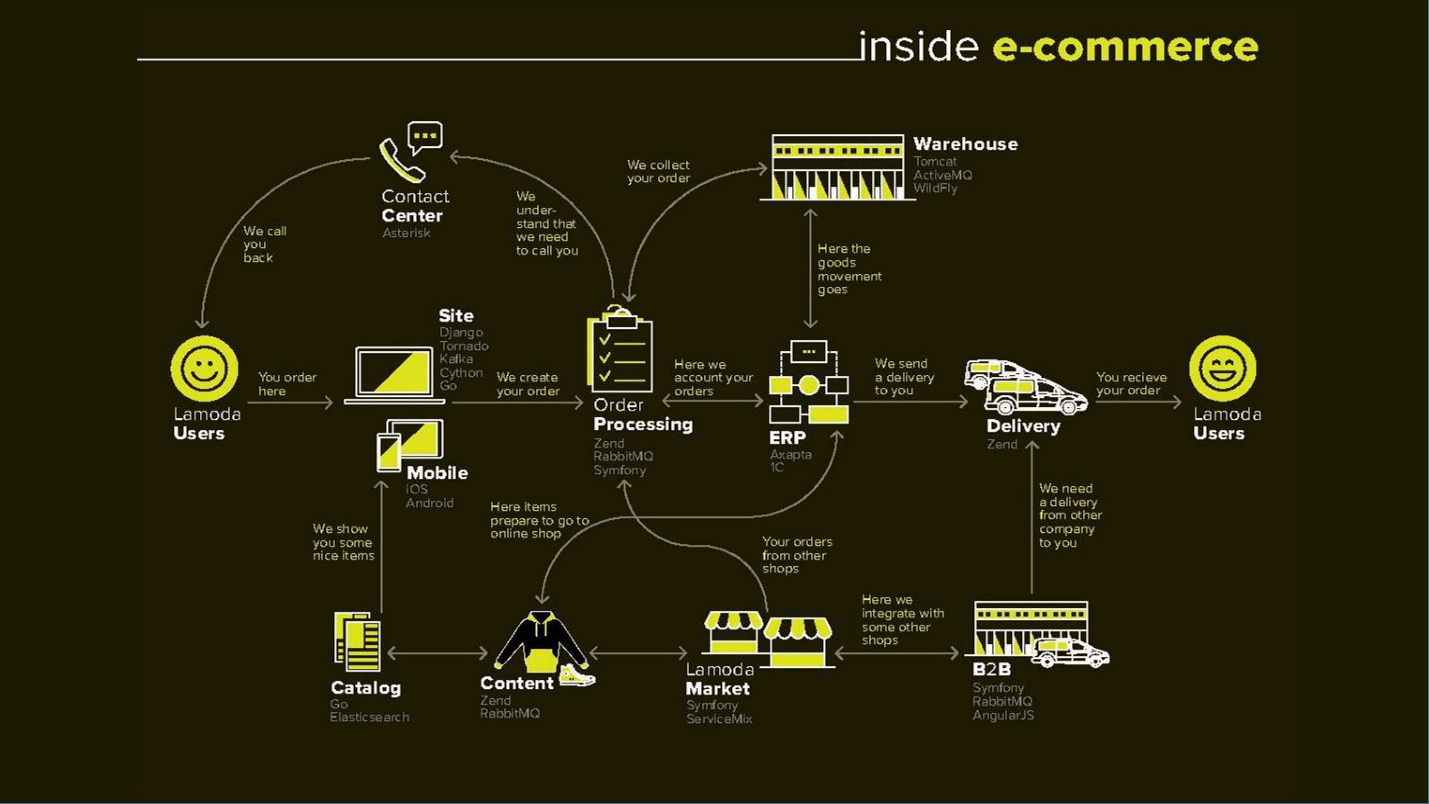
300 IT specialists develop and maintain over 100 internal services that are used by all 5,000 employees. Knowledge sharing is constantly happening.. Most users are internal employees. Sometimes it happens that teamlide has to be taught not only users, but also neighboring teams, new employees in their teams and in general everyone if new technologies appear. At times, it would be good to teach customers, because they demand the impossible.
Using the example of several case studies from Lamoda, I will illustrate the basic principles of adult education that you can apply in your work.
I will use the following terminology:
Case "ERP Developer Training"
A request for training usually looks like this:
- There are restrictions: approximately as much time, 2-3 presentations, 2 articles and some number of people who agree to spend an hour. I prepared a presentation, how to make it better, how many people and what time to call for training?
With this approach, the efficiency of the event will tend to zero, and here's why.

We have ERP - financial accounting system, which consists of two parts:
ERP interacts with all other systems. In addition, there are a lot of internal ERP users.
When the guys from ERP come to me with a proposal to tell all our developers (300 people!) How these systems work, I pull out my schema card from the store (on the left is the teacher - I, on the right - CA).

I start asking questions - let's go through them all.
My problems
- No one understands how our systems work. Ok, maybe they don’t have to? What is really the problem? What is burning? Where does it hurt?
After a few iterations, it turns out:
It would seem that there was one problem - it became two. But at the same time they became more specific and it is easier for us to understand further what to do with them.
Then we think about the result that we want to get:
- If the teams take A into account (do something specific), and the Helpdesk will ask questions to the address and use the documentation, will this solve the problem? It seems not to the end, because it would still be nice if they take into account B and B.
Add:
We consider the result immediately, when we are only talking about the problem, because this is the purpose of our training:
Lecture hall
Who usually makes decisions in a team, where is it important to consider A, B and C? Most often it is not the whole team, but only a technical. Therefore, if it is enough to talk about techlides about A, B, C, then this reduces the target audience - you need to teach only the Helplids and Helpdesk.
CA problems
Then we ask the question, what are the problems of Central Asia?
The problems are pretty obvious:
Here, when we look for the problems of Central Asia, we find motivation - those strings, for which we will continue to pull and try to help people. In this case, we see that the techlids have a rather negative motivation. To occupy them with a two-hour lecture on complex systems will be cruel. Helpdesk’s motivation is high, because it really solves their problems and helps in their work.
Then we have to look at the level of these people (we have two Central Asia).
A bit of theory. Conscious Competence
The scheme of conscious competence below.
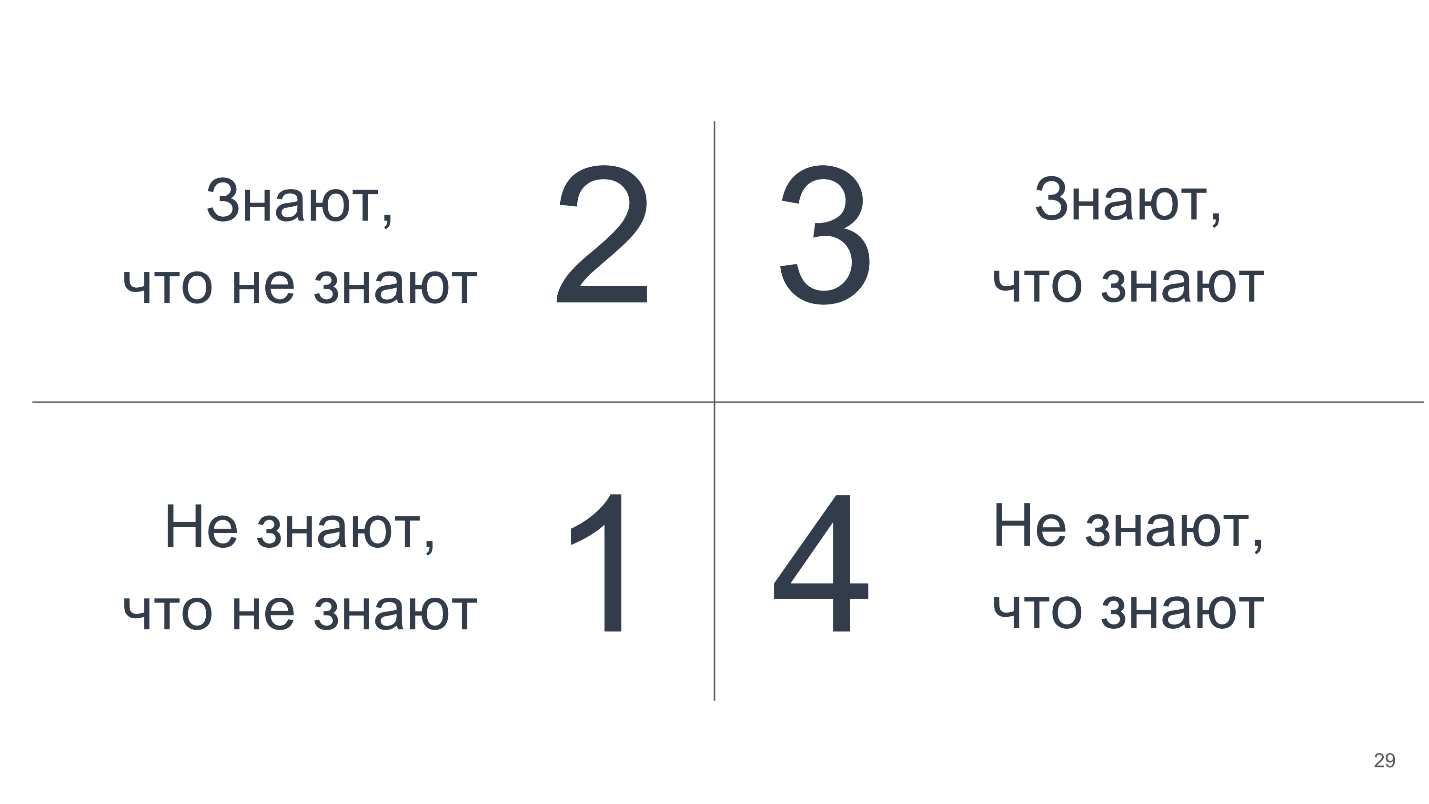
He is already in the fourth square, but since the last time he looked in the traffic regulations, they have changed, and according to the competence of the traffic regulations he is in the first quadrant.
This concept is not about the level of a person as a whole, but about individual knowledge (competencies). A person may, according to different competencies, be in different zones at the same time, just like our driver.
If we talk about learning, then most often refers to zone 3, which begins with knowledge.
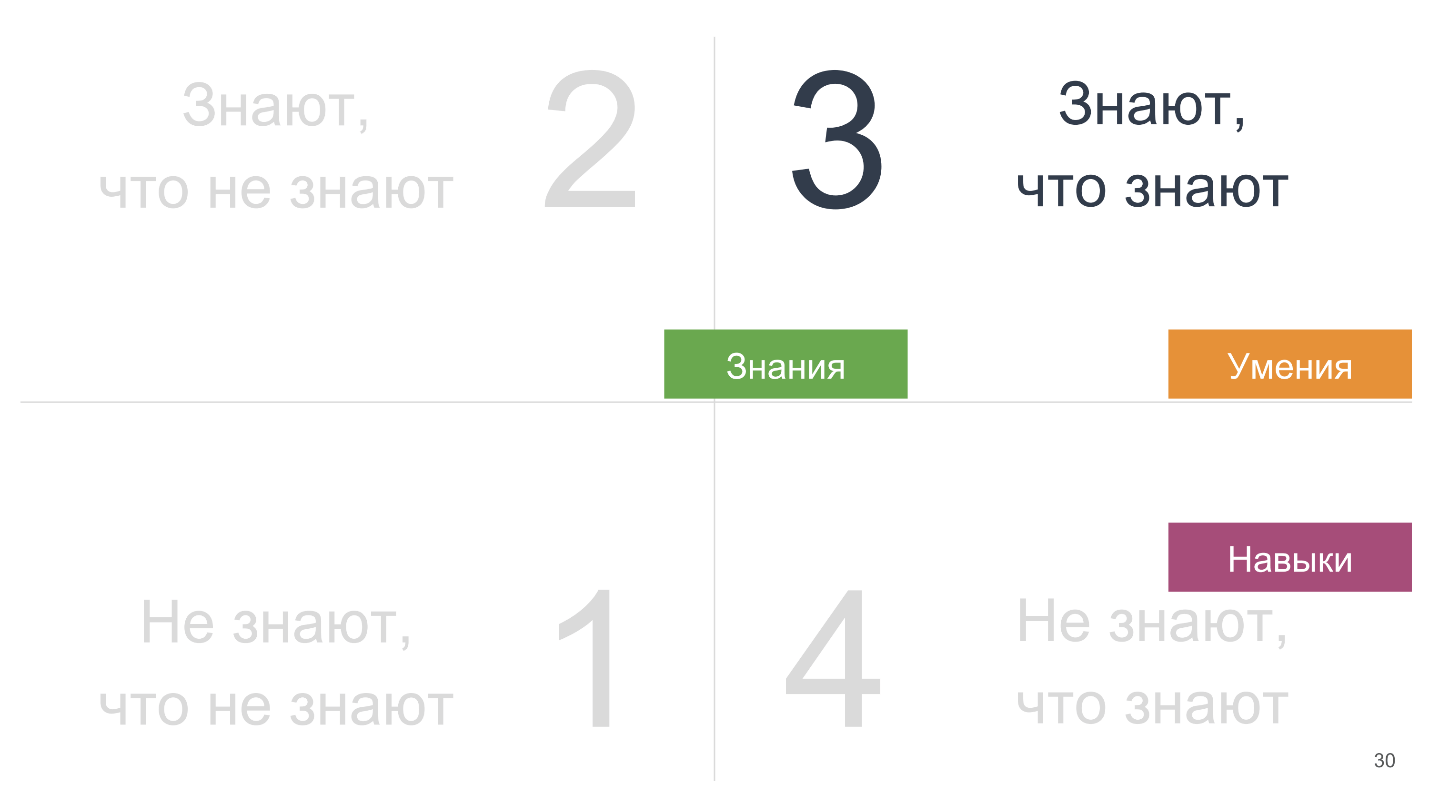
Knowledge is partially in zone 2: we have some horizons, but we did not dig deep. Knowledge accumulates and during practice flow into skills - these are technologies: do it once, do two, do three — checklists from repetition become skills.
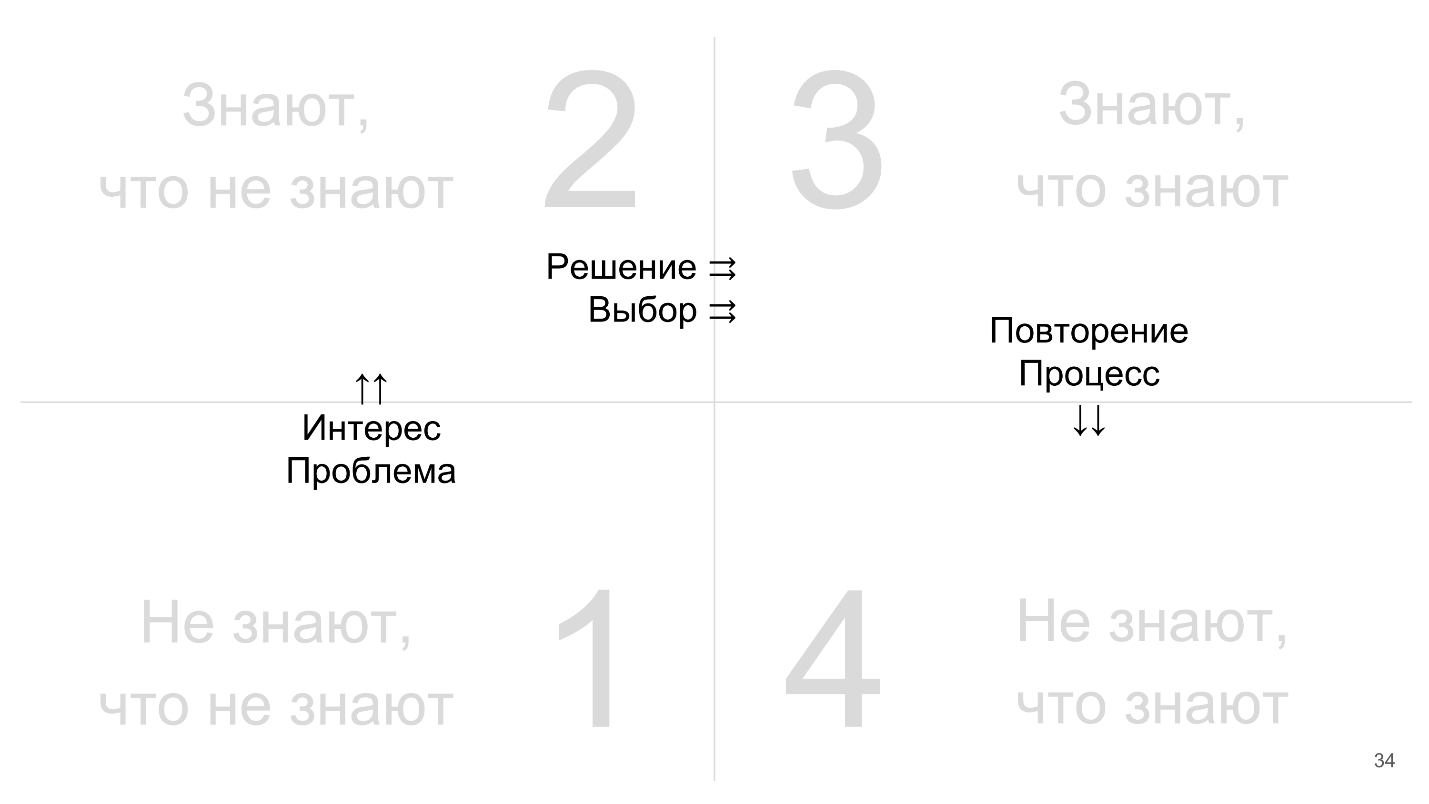
Many of us paid in advance for English courses (or any other courses), and then did not go. The reasons: the decision was not fully made, the choice was not fully made, too little effort was made to realize that this was necessary, and I would do it.
I dwell on it in such detail, because more often they begin to learn like this: “Look - technology: one, two, three!” - “It's great, but I am not ready to accept it, I’m not ready to go to the end of this training, and you already crammed. Most likely, the person will just fall off in the middle of the road.
Conscious competence is the third zone. All other zones are unconscious and incompetent.
We return to the case with ERP systems, where we wanted to conduct Knowledge Sharing for 300 people.
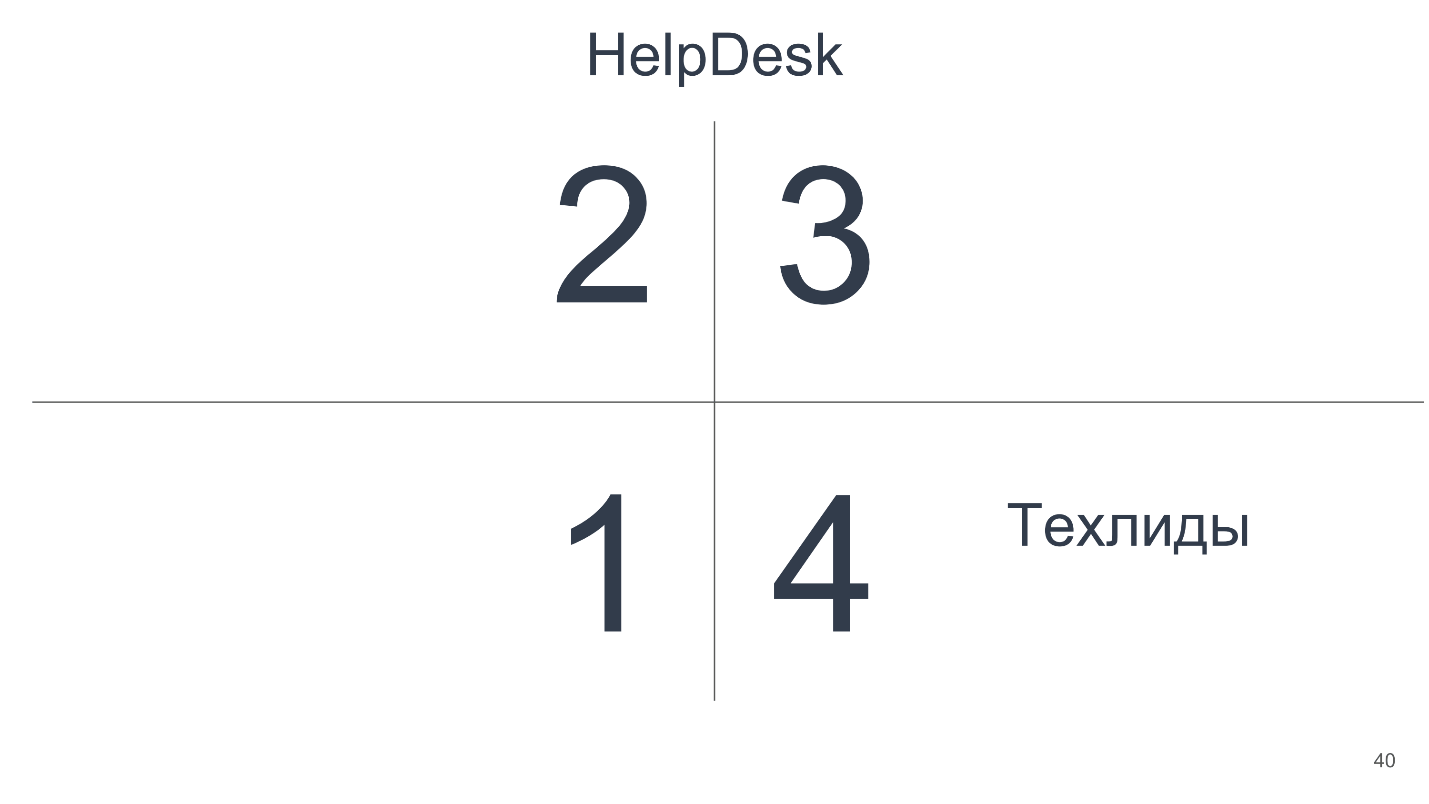
Helpdesk on the diagram is in the third zone on the border with the second. They would be the second if we showed them the system for the first time and told them to start supporting it. But they are already working with her, they are doing something and they know - that is, they are in the third zone.
The techlids are in the fourth zone - they know for sure that A, B and C should be taken into account, and it’s probably not worth telling them about it again for two hours.
How do we solve this problem?
Helpdesk was trained separately in two meetings:
Thus, all was relevant to what is happening. They were keenly interested.
The Techlids were not invited to a lecture, but they asked:
- How do you do it?
- We have such a workflow.
- Well, let's put the check-list here and here, and you will take these A, B, C into account in this workflow.
The guys were happy - they finally helped them to do their work.

The items “My task” and “Balance” remain. The task in the first case was to teach, and in the second - to help streamline the process. The dry residue was completely different. In further cases, you will see how our task and the dry rest of the audience change from the level of target audience.
The findings of the case "Training ERP developers":
But if not to learn, then what?
Let's see: we have my problems, Central Asia problems, my result, Central Asia level, and then my task. How does it change?
Newbies

In the first zone are often beginners. They come without knowing anything about the company. At this moment it is difficult for them to explain how everything works with us, it’s better to give at least some kind of card. Here we do not learn, but solve two problems:
Thus, our task is to inspire rather than teach. Burning eyes will not appear by themselves, someone must ignite them.

Case "Hiring Testers"
A QA manager comes to me and asks for help in understanding the situation where recruiters select resumes for unsuitable candidates. We look deeper - they "float" in the databases.
Once in the industry, it is customary to think that in any incomprehensible situation it is easiest to change recruiters. But we have a great team, it just needs to pump expertise in this area. In general, it is useful to teach recruiters - how do they otherwise find out what we need?
Recruiters are in zone 2 of our scheme, that is, “they know that they do not know” - they have heard something about something, but they do not really understand.
What result would love to get their training? Naturally, we do not expect that they suddenly begin to understand the bases. It would be nice to HR:
Then the task of the teacher :
In the remainder we get the expected result: understand what they say; know the keywords.
The story ended with the QA head held three meetings at which HR specialists directly deployed databases, opened windows, sent requests, received some data. So they remembered much more than if they had listened to a review lecture for 40 minutes with definitions. So it was possible to effectively solve the problem explained "on the fingers."

Case "Analytics Interns"
In the following example, a person is on the verge of the second zone to the third.

Every year we recruit a group of interns to the analyst. A fairly common practice is to read a course of lectures on a database, simply to compare the terminology adopted by the university with the slang in the company. They will work with this, and everything will be fine for them.
But we thought deeper. Here, in fact, the problem of the target audience is not a problem, but a sincere desire to learn. That same motivation. People really want to learn (also for salary)! This situation is ideal for learning.
The result we expect:
These are measurable metrics that can record and evaluate learning outcomes — what we love, and what makes us understand why we spent the time.
Task:
Remainder: the very skill - one, two, three.
We made a session with applied tasks. Every week, interns for 10-15 minutes were told about a certain solution, offered to try it. If it did not work out, why? Then the interns were still practicing on the spot, for a week they were engaged in exactly the same tasks, after which they switched to the next topic.
We used the so-called Kolb cycle .
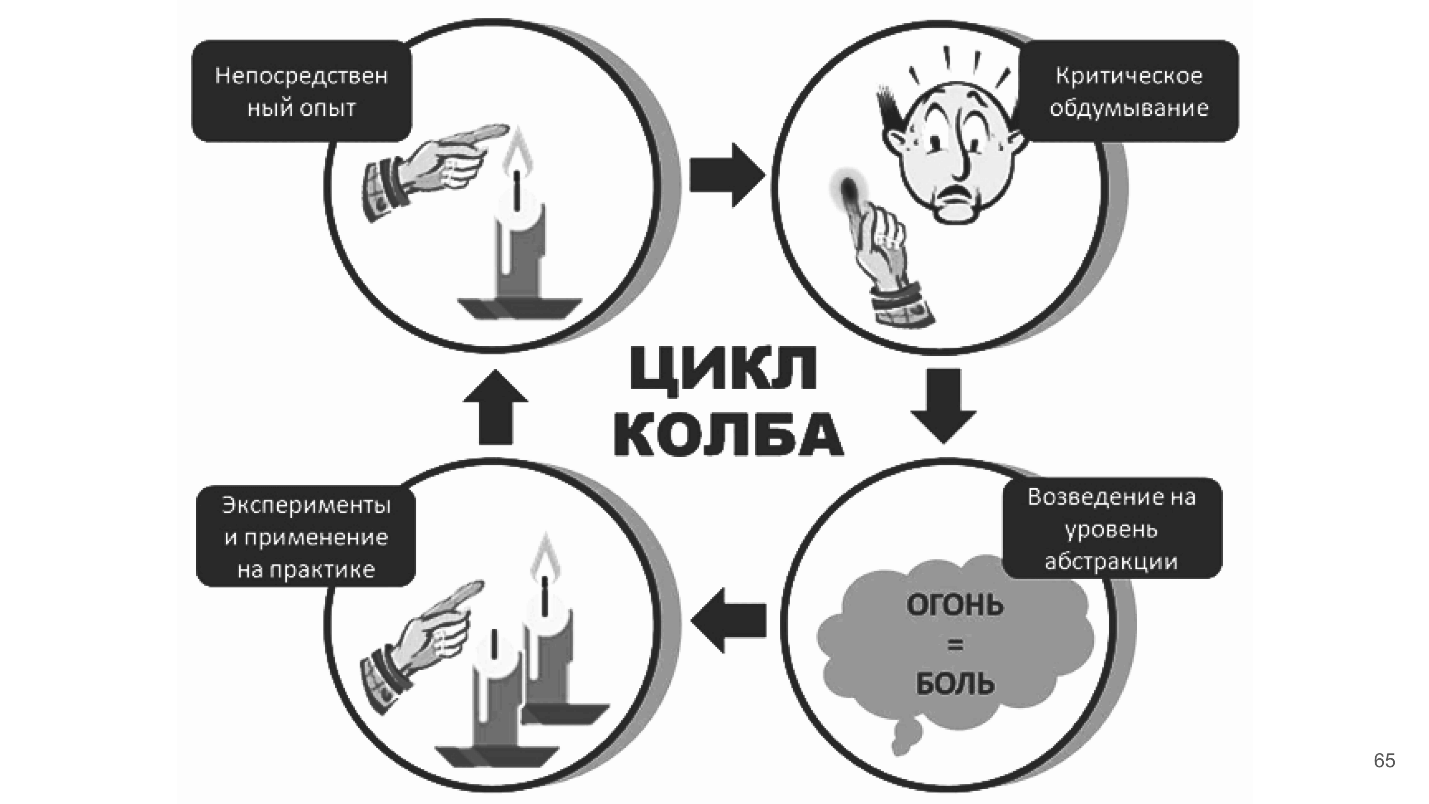
When you come to a training session, you are usually given a diagnostic exercise. If you have a skill, the development of which is aimed at training, then you do this exercise easily, effortlessly. More often it fail, because the skill is not enough. At this moment you are thinking about the experience gained, why you didn’t work out and want to find out how it was necessary. Then the trainer comes out, or you throw ideas on yourself - how it was possible to do better, that is, collect technology, critically think about it and raise it to the level of abstraction: “It was possible to do that.” Then you come up with a theory and then with this theory you proceed to the next exercise, apply it in it (“It seems, it works!”), And go into life, repeating it over and over again. This is the Kolb cycle.
If the task is to teach people exactly skill or technology, then it is convenient to apply the Kolb method.

When people in the third zone, and it would seem, they know and are able to, what can go wrong?

Case "Falling base"
Olya from BI (Business Intelligence) comes to me and says: “Once a week, our base falls and marketers seem to drop it. What to do?".
You can, of course, come to marketers and say: “You write bad requests - do not do it! Do this. Where are we going after this? Most likely, far away. Therefore, we went the other way.
We have a problem - the base drops once a week.
As a result, we want people to:
And they have no such problem, but there is an interest or another problem - they would like:
In general, marketers are not to blame - they have a huge amount of data of epic size. In order to build a prediction of user behavior, they actually take data from the database as they can without thinking about query optimization. This is not in their area of interest. If you think about their problems and find out how to help, then people will more favorably accept our help and training.
Our task is, on the one hand, to solve the problems of marketers, on the other hand, to convince them to do otherwise (Y). So that we can convince them, in the dry residue there should be some factual fact that if you do Y, you will get a better result than if you do X.
We conducted several sessions on SQL advanced for marketing. Before that, the guys from BI came, sat down with marketers, looked at how they made requests, asked questions, why, why. The preparation was quite lengthy. After that, BI understood how to help get better data and not to drop the base every time.
It worked - marketers gladly came and started to learn. If this did not happen, but simply stood in the calendar: “Come learn SQL”, they would say: “We know SQL, do not go - we have other tasks!”.
Thus, one of my tasks as a teacher is to persuade people, not just to teach.
Case "Feedback Timlid for Managers"
The development manager comes to me and suggests: “Let's conduct training for department heads on how to give feedback to the Timlids”. I wondered: the heads of the departments have been working for more than a year - probably, they have already given a feedback, and they know how to do it. It seems that they are in the fourth zone.

What is the problem ? At the Performance Review it turns out that approaches to timlids in different departments are somewhat different, due to which the career development of people who could move from one department to another at the same time is complicated. Different requirements - it is not clear what to do.
What result do we expect? We would like us to have a single approach in all departments.
What is the problem with department heads?? In general, and they have this problem, but not that it was paramount. However, you can go on the other hand:
Task: let's look at the cases - who works how, who faced what, we exchange experience, we systematize it. The bottom line is that the guys come out with complicated cases and can now at least have an approximate idea how to solve them.
We have worked on the problem of Central Asia, now we need to work on our task: to work out common rules. The bottom line is that in order to get our result, they must not only work out the rules, but also agree that they really need to take a unified approach, and decide to adhere to the general rules.
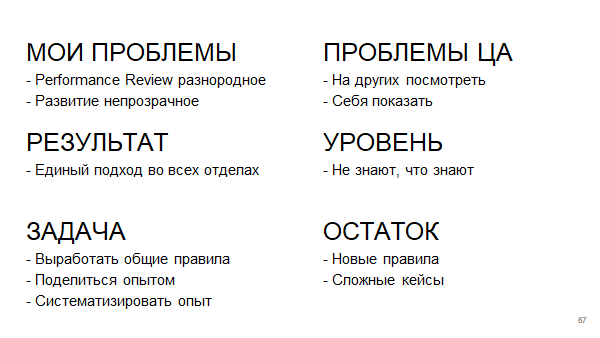
If you look at the task a little deeper - not just feedback training, as requested by the customer, - then you can come to the format of parsing complex cases. This also requires lengthy preparation: you need to come to everyone, sit in front of him and ask: “Dear, what hurts you? How are you doing this? What complicated cases were there? ”
To make high-quality training, it would be good to say that it hurts them, while promoting their interests in parallel.

So, one of our tasks is to help make decisions.
Framework
When we looked at the problems, the results, and the level, we defined our task and what dry residue people will endure, we can begin to talk about restrictions. We remember that we have limitations:

But they often forget that there is a budget in the first column . Sometimes it is non-zero, and it can be used.
Important note: Many people think that the teacher is good when he is in the fourth zone - where the car is driving, eyes closed. This is a misconception because the best teachers come from people in the third zone.. They are aware of what is happening, they know the methodology and can explain by it. Therefore, it is not always effective to teach yourself. If you communicate well, but you cannot explain why you are doing this, by what method, then it is better to call a person who is in a more conscious zone and can sort out the methodology. Sometimes it is more efficient to spend the budget than to do it yourself.
In the second column, processes are sometimes forgotten . I have already said that the process can both limit and help. Think about the process, think about it - maybe it can be modified to make it convenient for people to do what you want, and not always for this they need to be taught.
Decision!
Now we can finally talk about the decision and discuss the format:
An important parameter is the number of classes. Some skills without regular repetition are not learned. If you give a person one time technology, most likely he will not understand it. Therefore, we have, for example, a club of speakers, which I told about in February, where people regularly come and learn to speak in public. If you do not repeat, instead of moving from the third zone to the fourth, people are dumped into the second. Some things must be repeated regularly.
Results
To teach and ...
Besides learning, it would be good to be able to inspire, explain, persuade, facilitate and customize processes.

About this all is told in the books that I collected for you - they are placed on the diagram just in those areas in which they are needed.
But Yevgeny Golev ( cheaffa ) knows why, and how you really need to approach the transfer of knowledge within a company to achieve a result . And us on TeamLead Conf told, and now she will share with you many years of experience in adult education.

About the speaker: Yevgeniya Goleva has been engaged in adult education for 10 years, and recently she has combined this with the work of the maiden at Tech.Lamoda.
Contrary to popular belief, Lamoda is not just an online store, but a huge logistic system. The site itself is only 10% of the development, there is still an automated warehouse the size of a football field (imagine 5 more floors up), own delivery service in 600 cities, 3 call centers. World fashion brands buy logistics services from Lamoda in Russia and the CIS.

300 IT specialists develop and maintain over 100 internal services that are used by all 5,000 employees. Knowledge sharing is constantly happening.. Most users are internal employees. Sometimes it happens that teamlide has to be taught not only users, but also neighboring teams, new employees in their teams and in general everyone if new technologies appear. At times, it would be good to teach customers, because they demand the impossible.
Using the example of several case studies from Lamoda, I will illustrate the basic principles of adult education that you can apply in your work.
I will use the following terminology:
- I'am a teacher. In a situation when either I myself teach people, or I am a customer.
- They, the target audience - the group.
Case "ERP Developer Training"
A request for training usually looks like this:
- There are restrictions: approximately as much time, 2-3 presentations, 2 articles and some number of people who agree to spend an hour. I prepared a presentation, how to make it better, how many people and what time to call for training?
With this approach, the efficiency of the event will tend to zero, and here's why.

We have ERP - financial accounting system, which consists of two parts:
- Axapta, because we are an international company.
- 1C, because we pay salaries in Russia, Kazakhstan, Ukraine and Belarus.
ERP interacts with all other systems. In addition, there are a lot of internal ERP users.
When the guys from ERP come to me with a proposal to tell all our developers (300 people!) How these systems work, I pull out my schema card from the store (on the left is the teacher - I, on the right - CA).

I start asking questions - let's go through them all.
My problems
- No one understands how our systems work. Ok, maybe they don’t have to? What is really the problem? What is burning? Where does it hurt?
After a few iterations, it turns out:
- Teams forget important. They take into account the processes of Lamoda, forgetting about partner processes that may arise at any time.
- Helpdesk asks a lot of questions to the wrong address - not to those developers, distracting them from current work, and this is not very good.
It would seem that there was one problem - it became two. But at the same time they became more specific and it is easier for us to understand further what to do with them.
My result
Then we think about the result that we want to get:
- If the teams take A into account (do something specific), and the Helpdesk will ask questions to the address and use the documentation, will this solve the problem? It seems not to the end, because it would still be nice if they take into account B and B.
Add:
- Teams consider A, B and C .
- Helpdesk asks questions at and uses the documentation.
We consider the result immediately, when we are only talking about the problem, because this is the purpose of our training:
- Check if this solves the problem? Sometimes it happens that training, for which we did not think over the result in advance, does not solve the problem, but is simply a waste of time.
- The result focuses on what needs to be put into people's heads.
Lecture hall
Who usually makes decisions in a team, where is it important to consider A, B and C? Most often it is not the whole team, but only a technical. Therefore, if it is enough to talk about techlides about A, B, C, then this reduces the target audience - you need to teach only the Helplids and Helpdesk.
CA problems
Then we ask the question, what are the problems of Central Asia?
The problems are pretty obvious:
- Overloading the techlides with information — many systems pass through them, and the truth is.
- Helpdesk has a job, SLA is not maintained . Moreover, an emergency situation often occurs when an incident occurs, and support cannot find the right developer and suffers.
Here, when we look for the problems of Central Asia, we find motivation - those strings, for which we will continue to pull and try to help people. In this case, we see that the techlids have a rather negative motivation. To occupy them with a two-hour lecture on complex systems will be cruel. Helpdesk’s motivation is high, because it really solves their problems and helps in their work.
CA Level
Then we have to look at the level of these people (we have two Central Asia).
A bit of theory. Conscious Competence
The scheme of conscious competence below.

- They do not know they do not know. Imagine a child of 4 years old who first saw a red car with a man behind the wheel. He thinks: “Wow, how great! I also want to turn the steering wheel - the machine is driving from the steering wheel! ”.
- They know they do not know. At 10 years old, the child already guesses that the machine is not driving, but there are mechanisms that somehow add up to each other, and he will have to study it.
- Know they know. At age 18, a person goes to study at a driving school, and there he is told about the rules of the road, how to release the clutch pedal so as not to stall on the slide. He learns to look in the mirror and taxi to the right lane, turning on the turn signal. He suffers, but learns. He has a long checklist to do.
- Do not know what they know. After many years, he already drives, as he breathes: he shaves with one hand, the other pulls out something from his pocket, which he rules - only God knows. And while he somehow still manages to fit into complex turns.
He is already in the fourth square, but since the last time he looked in the traffic regulations, they have changed, and according to the competence of the traffic regulations he is in the first quadrant.
This concept is not about the level of a person as a whole, but about individual knowledge (competencies). A person may, according to different competencies, be in different zones at the same time, just like our driver.
If we talk about learning, then most often refers to zone 3, which begins with knowledge.

Knowledge is partially in zone 2: we have some horizons, but we did not dig deep. Knowledge accumulates and during practice flow into skills - these are technologies: do it once, do two, do three — checklists from repetition become skills.

- The transition from the first zone to the second occurs with children in case of interest (eyes wide open, red typewriter). But adults, unfortunately, are already more callous, they can be hooked on to problems. It is better if there is interest, but more reliably through problems.
- From the second zone to the third person passes, when he already has fragmentary knowledge from different areas. It takes a lot of energy to choose which one to spend your time on right now, make a decision and start to study it.
Many of us paid in advance for English courses (or any other courses), and then did not go. The reasons: the decision was not fully made, the choice was not fully made, too little effort was made to realize that this was necessary, and I would do it.
I dwell on it in such detail, because more often they begin to learn like this: “Look - technology: one, two, three!” - “It's great, but I am not ready to accept it, I’m not ready to go to the end of this training, and you already crammed. Most likely, the person will just fall off in the middle of the road.
- The transition from the third zone to the fourth occurs through repetition and process. Sometimes we taught people, gave them some kind of technology, but it is not applicable in their real life, their process is different. It is important to remember that when you give a technology, you must check that it fits - it does not interfere and helps.
Conscious competence is the third zone. All other zones are unconscious and incompetent.
We return to the case with ERP systems, where we wanted to conduct Knowledge Sharing for 300 people.

Helpdesk on the diagram is in the third zone on the border with the second. They would be the second if we showed them the system for the first time and told them to start supporting it. But they are already working with her, they are doing something and they know - that is, they are in the third zone.
The techlids are in the fourth zone - they know for sure that A, B and C should be taken into account, and it’s probably not worth telling them about it again for two hours.
How do we solve this problem?
Helpdesk was trained separately in two meetings:
- Simple lecture, answers to questions, 2 weeks of work.
- After 2 weeks, the lecture is more complicated, the answers to the questions that have appeared.
Thus, all was relevant to what is happening. They were keenly interested.
The Techlids were not invited to a lecture, but they asked:
- How do you do it?
- We have such a workflow.
- Well, let's put the check-list here and here, and you will take these A, B, C into account in this workflow.
The guys were happy - they finally helped them to do their work.

The items “My task” and “Balance” remain. The task in the first case was to teach, and in the second - to help streamline the process. The dry residue was completely different. In further cases, you will see how our task and the dry rest of the audience change from the level of target audience.
The findings of the case "Training ERP developers":
- Different levels of CA are different approaches. People need to work in different ways.
- Do not always need to learn.
But if not to learn, then what?
Let's see: we have my problems, Central Asia problems, my result, Central Asia level, and then my task. How does it change?
Newbies

In the first zone are often beginners. They come without knowing anything about the company. At this moment it is difficult for them to explain how everything works with us, it’s better to give at least some kind of card. Here we do not learn, but solve two problems:
- the simplest is not to demotivate, not to frighten ;
- interest is about those most burning eyes.
Thus, our task is to inspire rather than teach. Burning eyes will not appear by themselves, someone must ignite them.

Case "Hiring Testers"
A QA manager comes to me and asks for help in understanding the situation where recruiters select resumes for unsuitable candidates. We look deeper - they "float" in the databases.
Once in the industry, it is customary to think that in any incomprehensible situation it is easiest to change recruiters. But we have a great team, it just needs to pump expertise in this area. In general, it is useful to teach recruiters - how do they otherwise find out what we need?
Recruiters are in zone 2 of our scheme, that is, “they know that they do not know” - they have heard something about something, but they do not really understand.
What result would love to get their training? Naturally, we do not expect that they suddenly begin to understand the bases. It would be nice to HR:
- understood what the candidate was talking about;
- owned a terminology that can google.
Then the task of the teacher :
- very simple to explain, without complications (not everyone can);
- give a map for a landmark.
In the remainder we get the expected result: understand what they say; know the keywords.
The story ended with the QA head held three meetings at which HR specialists directly deployed databases, opened windows, sent requests, received some data. So they remembered much more than if they had listened to a review lecture for 40 minutes with definitions. So it was possible to effectively solve the problem explained "on the fingers."

Case "Analytics Interns"
In the following example, a person is on the verge of the second zone to the third.

Every year we recruit a group of interns to the analyst. A fairly common practice is to read a course of lectures on a database, simply to compare the terminology adopted by the university with the slang in the company. They will work with this, and everything will be fine for them.
But we thought deeper. Here, in fact, the problem of the target audience is not a problem, but a sincere desire to learn. That same motivation. People really want to learn (also for salary)! This situation is ideal for learning.
The result we expect:
- less questions and errors of certain types;
- higher speed work.
These are measurable metrics that can record and evaluate learning outcomes — what we love, and what makes us understand why we spent the time.
Task:
- give technology;
- show shortcuts.
Remainder: the very skill - one, two, three.
We made a session with applied tasks. Every week, interns for 10-15 minutes were told about a certain solution, offered to try it. If it did not work out, why? Then the interns were still practicing on the spot, for a week they were engaged in exactly the same tasks, after which they switched to the next topic.
We used the so-called Kolb cycle .

When you come to a training session, you are usually given a diagnostic exercise. If you have a skill, the development of which is aimed at training, then you do this exercise easily, effortlessly. More often it fail, because the skill is not enough. At this moment you are thinking about the experience gained, why you didn’t work out and want to find out how it was necessary. Then the trainer comes out, or you throw ideas on yourself - how it was possible to do better, that is, collect technology, critically think about it and raise it to the level of abstraction: “It was possible to do that.” Then you come up with a theory and then with this theory you proceed to the next exercise, apply it in it (“It seems, it works!”), And go into life, repeating it over and over again. This is the Kolb cycle.
If the task is to teach people exactly skill or technology, then it is convenient to apply the Kolb method.

When people in the third zone, and it would seem, they know and are able to, what can go wrong?

Case "Falling base"
Olya from BI (Business Intelligence) comes to me and says: “Once a week, our base falls and marketers seem to drop it. What to do?".
You can, of course, come to marketers and say: “You write bad requests - do not do it! Do this. Where are we going after this? Most likely, far away. Therefore, we went the other way.
We have a problem - the base drops once a week.
As a result, we want people to:
- stopped making X;
- started to do Y - the way we need.
And they have no such problem, but there is an interest or another problem - they would like:
- get data more precisely;
- get data faster.
In general, marketers are not to blame - they have a huge amount of data of epic size. In order to build a prediction of user behavior, they actually take data from the database as they can without thinking about query optimization. This is not in their area of interest. If you think about their problems and find out how to help, then people will more favorably accept our help and training.
Our task is, on the one hand, to solve the problems of marketers, on the other hand, to convince them to do otherwise (Y). So that we can convince them, in the dry residue there should be some factual fact that if you do Y, you will get a better result than if you do X.
We conducted several sessions on SQL advanced for marketing. Before that, the guys from BI came, sat down with marketers, looked at how they made requests, asked questions, why, why. The preparation was quite lengthy. After that, BI understood how to help get better data and not to drop the base every time.
It worked - marketers gladly came and started to learn. If this did not happen, but simply stood in the calendar: “Come learn SQL”, they would say: “We know SQL, do not go - we have other tasks!”.
Thus, one of my tasks as a teacher is to persuade people, not just to teach.
Case "Feedback Timlid for Managers"
The development manager comes to me and suggests: “Let's conduct training for department heads on how to give feedback to the Timlids”. I wondered: the heads of the departments have been working for more than a year - probably, they have already given a feedback, and they know how to do it. It seems that they are in the fourth zone.

What is the problem ? At the Performance Review it turns out that approaches to timlids in different departments are somewhat different, due to which the career development of people who could move from one department to another at the same time is complicated. Different requirements - it is not clear what to do.
What result do we expect? We would like us to have a single approach in all departments.
What is the problem with department heads?? In general, and they have this problem, but not that it was paramount. However, you can go on the other hand:
- look at others;
- to show yourself.
Task: let's look at the cases - who works how, who faced what, we exchange experience, we systematize it. The bottom line is that the guys come out with complicated cases and can now at least have an approximate idea how to solve them.
We have worked on the problem of Central Asia, now we need to work on our task: to work out common rules. The bottom line is that in order to get our result, they must not only work out the rules, but also agree that they really need to take a unified approach, and decide to adhere to the general rules.

If you look at the task a little deeper - not just feedback training, as requested by the customer, - then you can come to the format of parsing complex cases. This also requires lengthy preparation: you need to come to everyone, sit in front of him and ask: “Dear, what hurts you? How are you doing this? What complicated cases were there? ”
To make high-quality training, it would be good to say that it hurts them, while promoting their interests in parallel.

So, one of our tasks is to help make decisions.
Framework
When we looked at the problems, the results, and the level, we defined our task and what dry residue people will endure, we can begin to talk about restrictions. We remember that we have limitations:

But they often forget that there is a budget in the first column . Sometimes it is non-zero, and it can be used.
Important note: Many people think that the teacher is good when he is in the fourth zone - where the car is driving, eyes closed. This is a misconception because the best teachers come from people in the third zone.. They are aware of what is happening, they know the methodology and can explain by it. Therefore, it is not always effective to teach yourself. If you communicate well, but you cannot explain why you are doing this, by what method, then it is better to call a person who is in a more conscious zone and can sort out the methodology. Sometimes it is more efficient to spend the budget than to do it yourself.
In the second column, processes are sometimes forgotten . I have already said that the process can both limit and help. Think about the process, think about it - maybe it can be modified to make it convenient for people to do what you want, and not always for this they need to be taught.
Decision!
Now we can finally talk about the decision and discuss the format:
- Individually / 6 small group / 12-16 training group / x * 12.
- Lecture / meeting / demo / training / workshop / business game / simulation.
- One-time / several meetings / regular club.
- Working / non-working time.
- Weekdays / Weekend.
- 1 hour / 2-4 hours / 8 hours per day.
- Morning / Lunch / Evening.
An important parameter is the number of classes. Some skills without regular repetition are not learned. If you give a person one time technology, most likely he will not understand it. Therefore, we have, for example, a club of speakers, which I told about in February, where people regularly come and learn to speak in public. If you do not repeat, instead of moving from the third zone to the fourth, people are dumped into the second. Some things must be repeated regularly.
Results
- Central Asia's problems are its motivation. It is important to look at this, and this is a great preparatory work. Even if you do not teach yourself, but order training, unfortunate HR come to you and ask: “What problems do you have there?”, It is important not to pass off your problems as people's problems. Most often these are different problems. If people from Training & Development solve your problems, they will not fall into Central Asia. It is important to know what really hurts people, how you can help them.
- Different level - different task. No need to try to teach people in zones 1, 2, 4! Try to properly evaluate this level.
- Do not always need to learn . But if you learn, then do it according to Kolb.
To teach and ...
Besides learning, it would be good to be able to inspire, explain, persuade, facilitate and customize processes.

About this all is told in the books that I collected for you - they are placed on the diagram just in those areas in which they are needed.
More useful recommendations on working with teams will be available on TeamLead Conf in Moscow on February 25 and 26. Specifically, knowledge management will be discussed at the KnowledgeConf on April 26, starting with what tools to use for documentation, how to reduce risks, and how faster it is to board new employees and deal with the bus factor. APPLY if Charite in knowledge sharing as a Eugene
Subscribing to the newsletter will help not to miss new items, such as this article-transcript.
